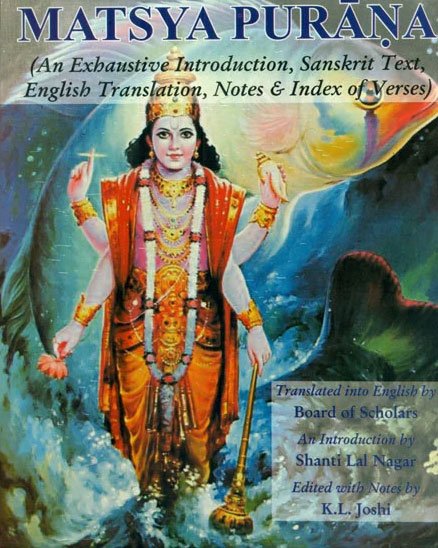The Matsya Purana (critical study)
by Kushal Kalita | 2018 | 74,766 words | ISBN-13: 9788171103058
This page relates ‘Imagery in the Matsyapurana’ of the English study on the Matsya-purana: a Sanskrit text preserving ancient Indian traditions and legends written in over 14,000 metrical verses. In this study, the background and content of the Matsyapurana is outlined against the cultural history of ancient India in terms of religion, politics, geography and architectural aspects. It shows how the encyclopedic character causes the text to deal with almost all the aspects of human civilization.
Part 4 - Imagery in the Matsyapurāṇa
Imagery means figurative illustration in any literature. It actually represents mental images collectively.[1]
In the words of M.H.Abrams,
“Imagery (that is, images taken collectively) is used to signify all the objects and qualities of sense perception referred to in a poem or other work of literature, whether by literal description, by allusion, or in the analogues used in its similes and metaphors.” [2]
Imagery includes auditory, tactile (touch), olfactory (smell), gustatory (taste), or kinesthetic (sensation of movement) as well as visual qualities. It is also said in Abrams’ work that, most commonly, imagery is used to signify figurative language, especially the vehicles of metaphors and similes.[3] Imagery is the minute observation of the poet through which he can pour out the inner feelings of his heart in his writings. It enables a reader to connect the matter of description as aimed at by the poet about which the reader does not have even the abstract idea with any source available around. In short Imagery brings two similar objects in one platform.
In the Matsyapurāṇa, a good number of narratives have carried imagery and the purpose of the poet is executed in the concerned references by these imageries. In most of the cases the imagery has been used as the tool for similes and metaphors. Images of moon are found abundantly in the Matsyapurāṇa which represent a common imagery in Sanskrit literature. The beauty and the brightness of the moon are ever charming and that is why it is in common use for figurative illustration while describing the beauty of a lady. For example in the Matsyapurāṇa the poet has compared the face of Ilā with full moon.
Her enchanting beauty is thus conveyed to the reader through the image of beauty of the full moon
unnataśroṇijaghanā padmapatrāyatekṣṇaṇā/
pūrṇenduvadanā tanvī vilāsollāsitekṣaṇā// [4]
There are other instances where the image of beautiful moon is well utilised for depicting a beautiful woman.
Along with the beauty of the moon, the brilliance of the sun is also used for figurative illustration and in the Matsyapurāṇa this imagery is aptly employed while describing the powerful and shining character of Pārvatī due to her severe austerities:
jitārkajvalanajvālā tapastejomayī hyumā.[5]
Another example
sā tu tān vidhivatpūjyān pūjayitvā vidhānataḥ/
uvācādityasaṃkāśān munīn sapta satī śanaiḥ// [6]
Again the blazing fire is also taken for imagery in the Matsyapurāṇa in different contexts. For instance
dvau māṃ śokāvagnikalpau dahetāṃ kacasya nāśastava caivopaghātaḥ/
kacasya nāśe mama nāsti śarma tavopaghāte jīvituṃ nāsmi śaktā// [7]
In this verse the pain of heart is portrayed through the image of burning fire. The double pain felt by Devayānī has burnt her heart just like burning fire hurts one after getting connected with it. One may not feel Devayānī’s pain but through the imagination of the poet the reader may get the sensation through the imagery. Such image of burning fire is very catching in literary world too. The same image of fire is always a subject for comparison with anger specially in case of Lord Śiva’s wrath because when he gets angry nobody can escape but turns into ashes, just like the burning fire.
The third Eye of Śiva became ablaze and ready to consume the whole world from the fire of wrath produced from it when Kāmadeva triggered the love-arrow at meditating Lord Śiva.
For example
tataḥ kopānalodbhūtaghorahuṅkārabhīṣaṇe//
babhūva vadane netraṃ tṛtīyamanalākulam/
rudrasya raudravapuṣo jagatsaṃhārabhairavam// [8]
Freshness and novelty are the two major factors in the success of image. Through novelty freshness acts as the power that can reveal those things which a reader cannot even realise before.
In the Matsyapurāṇa also the poet has drawn such images. An instance of this idea is:
uvācānāvilaṃ vākyamalpākṣaraparisphuṭam/
daityendramarkavṛndānāṃ vibhrantaṃ bhāsvaraṃ vapuḥ// [9]
The chamberlain started with a short but fully significant speech and then said to the king Tārakāsura, who was sitting brilliant as if hundreds of suns were blazing. Here the poet’s imagination helps the reader get a perfect picture of king Tārakāsura in his brilliancy with prowess and capability everywhere just like many blazing suns.
The mighty King Yayāti and his braveness is remarkable and the poet of the Matsyapurāṇa has correctly chosen the image of lion, the king of the beasts for showcasing the valour of the very king in sa rājā siṃhavikrānto yuvā viṣayagocaraḥ.[10]
In this way it is seen that the author of the Matsyapurāṇa has successfully used similes and metaphors in drawing the correct image as the case may be. But it must be mentioned here that the Matsyapurāṇa not being a poetical work and being mostly of descriptive and deductive nature, doesn’t contain a very high class of imagery as found in other literary works of Sanskrit.
Footnotes and references:
[1]:
Oxford Dictionary, p.370
[2]:
M.H.Abrams, A Glossary of Literary Terms, p.176
[3]:
Ibid., p.77
[4]:
Matsyapurāṇa, 11.49
[5]:
Ibid., 154.422
[6]:
Ibid., 154.319
[7]:
Ibid., 25.53
[8]:
Ibid., 154.249-250
[9]:
Ibid., 154.2
[10]:
Ibid., 34.7
